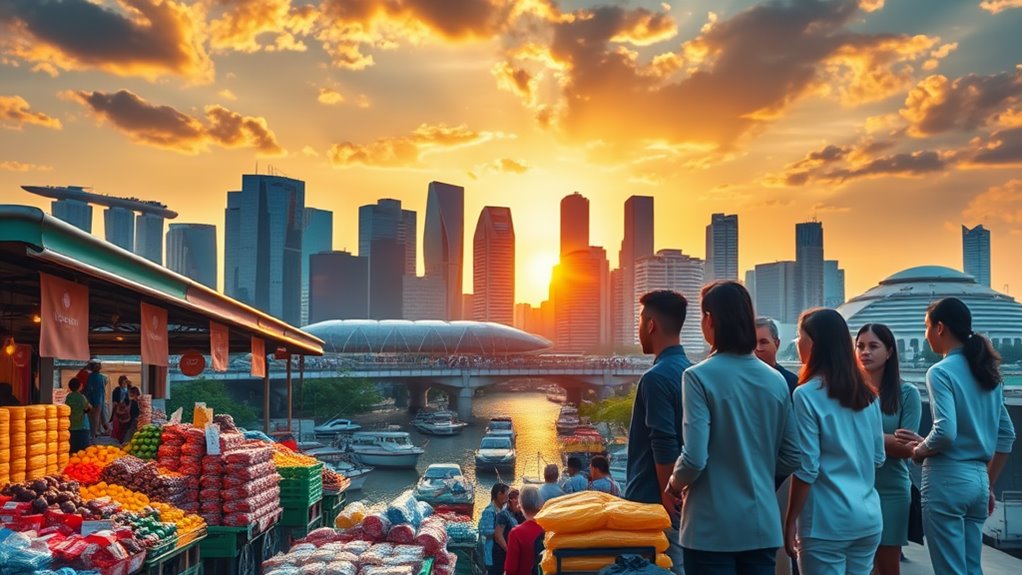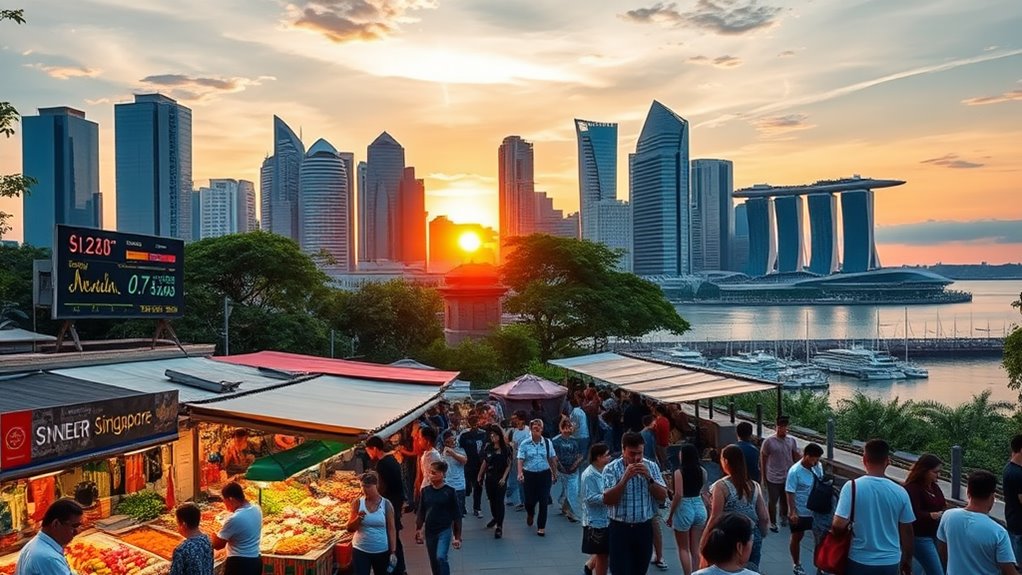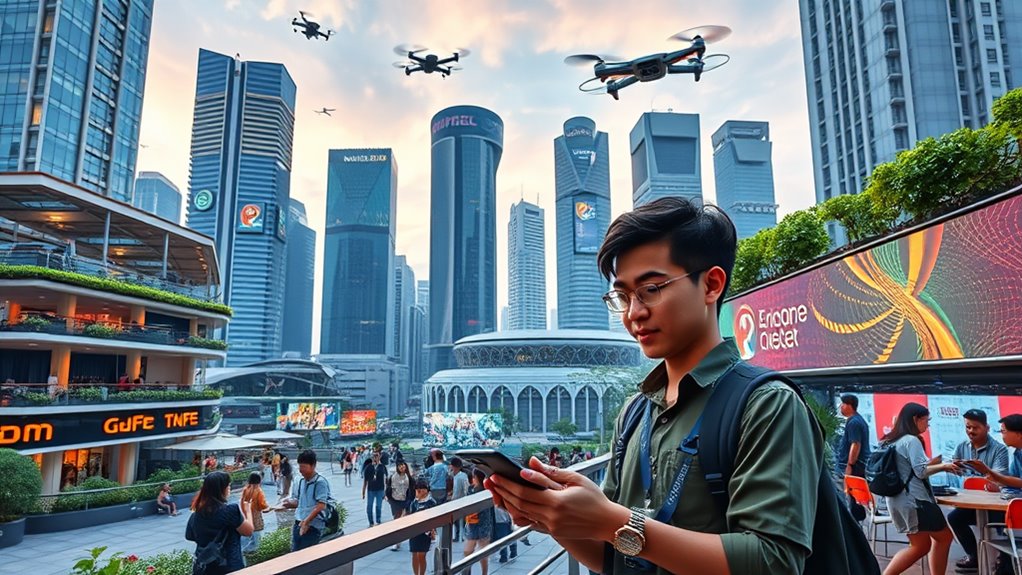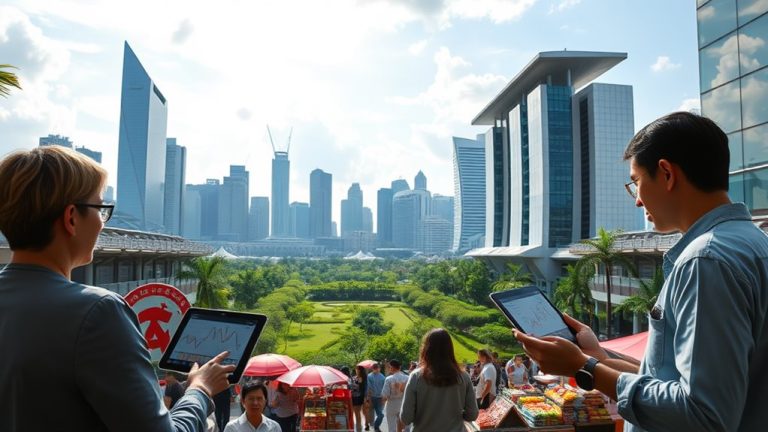You might think economic policies are boring, but they're actually the backbone of Singapore's future! In 2025, a mix of creative strategies is set to enhance growth and resilience. From the exciting Johor-Singapore Special Economic Zone to smart fiscal decisions, there's a lot happening. Curious about how these moves will shape the job market and keep inflation in check? Let's examine the eight key policies that will redefine Singapore's economic landscape!
Favourable Growth Prospects
When you think about Singapore's economy, prepare for some exciting news! In 2025, it's set to grow by 2.8%, right in line with its potential.
This isn't just luck; it's driven by strong growth drivers. The manufacturing sector, especially electronics, will shine thanks to a booming global semiconductor market.
Plus, trade-related services, finance, and ICT are all buzzing with resilient external demand. These modern services are like the cool kids in class, thriving on digitalization and AI.
Sure, there are risks like geopolitical tensions, but Singapore's economic resilience shines bright. Understanding Business Licensing Types is essential for new entrepreneurs looking to capitalize on these growth opportunities.
Seize the opportunities ahead! With these engines of growth, you can see a future filled with potential and freedom for everyone.
Johor-Singapore Special Economic Zone: A New Frontier
Singapore's economic landscape is about to get even more exciting with the Johor-Singapore Special Economic Zone (JS-SEZ).
This massive 3,571 square kilometer zone in southern Johor aims to enhance cross-border collaboration and economic integration between Singapore and Malaysia. Imagine industries like data centers, electronics, renewable energy, and tourism thriving together!
With the Johor Bahru-Singapore Rapid Transit System (RTS) Link set to finish by 2026, getting around will become a breeze.
Plus, the JS-SEZ is expected to create around 20,000 skilled jobs in five years. That's a win-win for both regions!
Sure, there are challenges to tackle, but the potential for growth is huge. You'll want to keep an eye on this exciting frontier!
Inflation to Ease to Pre-Pandemic Rates

As we look ahead, it's exciting to see inflation in Singapore projected to ease back to pre-pandemic rates by 2025!
This shift promises to reshape consumer behavior positively. Here's what you can expect:
- Headline inflation is forecasted to drop to 1.7%, with core inflation at 1.5%.
- Rental accommodation costs will normalize, relieving financial pressure.
- Global commodity prices for energy and food will remain stable, supporting these inflation trends.
With contained imported inflation and a stronger Singapore dollar, you'll notice prices stabilizing.
Consumers will feel the relief, making it easier to plan budgets and enjoy a little more freedom.
It's a great time to think about how these changes can shape your financial future!
Fiscal Policy Balancing Long-Term Goals and Immediate Needs
Balancing long-term goals with immediate needs is no easy feat, but it's essential for a thriving economy. Singapore's fiscal strategy navigates this challenge by ensuring fiscal responsibility while also promoting economic resilience. The Forward Singapore initiative focuses on investments in housing, healthcare, and workforce transformation, improving your quality of life. With a cumulative surplus of S$1.8 billion from FY2021 to FY2024, the government's got some wiggle room for 2025.
Here's a quick overview of key areas:
| Area | Immediate Support | Long-Term Investment |
|---|---|---|
| Housing | Subsidies for families | Affordable housing projects |
| Healthcare | Subsidized medical costs | Improved healthcare facilities |
| Workforce | Training grants | Skill development programs |
| Businesses | Tax relief | Innovation grants |
| Cost of Living | Direct cash assistance | Sustainable economic growth |
This balance is essential for everyone's future! Additionally, the government's tax incentives and exemptions are designed to stimulate business growth, which plays a crucial role in the overall economic strategy.
S$NEER Policy Easing

In regard to managing the economy, the Monetary Authority of Singapore (MAS) is always on its toes.
They're eyeing a potential easing in the S$NEER policy by mid-2025. This careful approach helps with inflation targeting while maneuvering exchange rate dynamics.
Here's what you should know:
- A slight slowdown in S$NEER appreciation could happen as core inflation dips to 1.0–2.0%.
- The MAS is reacting to growth uncertainties linked to global trade changes and geopolitical tensions.
- Strong economic fundamentals will likely keep the Singapore dollar resilient, even amid global turbulence.
Monetary Policy Adjustments
While steering through the complexities of a changing global economy, the Monetary Authority of Singapore (MAS) made a significant move in January 2025 by easing its monetary policy. This was a bold step, marking its initial adjustment since March 2020.
You see, they aimed to support economic stability amid external challenges. With anticipated slower growth and subdued inflation, it was time for some monetary stimulus measures. Core inflation is expected to dip to 1.0% to 2.0% in 2025, creating room for interest rate adjustments.
The MAS also slightly reduced the appreciation pace of the Singapore Dollar Nominal Effective Exchange Rate (S$NEER). They're keeping a close eye on global trade shifts that could affect Singapore's growth.
Exciting times ahead!
Advancements in Digitalisation and Innovation

As Singapore dives headfirst into the technological age, you can really feel the excitement buzzing in the air!
The nation's commitment to digitalisation is crucial for staying competitive in the global economy. The Punggol Digital District (PDD) is a game-changer, creating about 28,000 new jobs through tech collaboration between industry and academia.
Singapore's dedication to digitalisation fuels competitiveness, with the Punggol Digital District generating 28,000 jobs through innovative tech partnerships.
It's more than just a workspace; it's a vibrant community hub.
- Boosting the digital economy with groundbreaking solutions.
- Enhancing quality of life with dining, leisure, and retail options.
- Fostering innovation to adapt to the fast-evolving global landscape. Additionally, initiatives like AI Singapore play a pivotal role in promoting collaboration among various sectors to drive innovation.
Commitment to Sustainable Development
Singapore isn't just about tech and innovation; it's also making a serious commitment to sustainable development. The Tuas Nexus project is a game-changer. It integrates waste management with sustainable energy, treating used water and food waste while being completely energy self-sufficient. This aligns with Singapore's eco-friendly goals and improves waste management capabilities.
Here's a quick look at the commitment:
| Key Focus Areas | Initiatives |
|---|---|
| Sustainable Energy | Tuas Nexus providing self-sufficient energy |
| Waste Management | Integrated treatment of used water and food waste |
| Environmental Stewardship | Balancing growth with eco-friendly practices |
Conclusion
In 2025, Singapore's economic landscape is buzzing with potential! With smart policies in place, like the Johor-Singapore Special Economic Zone and a push for innovation, the future looks bright. As inflation eases and digital advancements take off, job opportunities will soar. Plus, the commitment to sustainability shows that growth doesn't have to come at the planet's expense. Exciting times ahead, right? Singapore is gearing up for a strong, resilient future—let's keep an eye on it!
